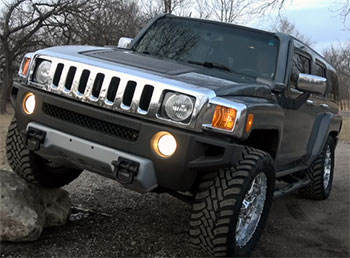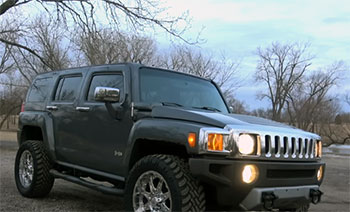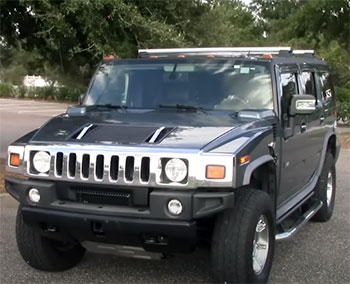I’ve always been drawn to vehicles that make a statement, and few do it as boldly as the Hummer H2 and H3. As an SUV enthusiast who’s owned and driven both, I’ve navigated city streets, tackled rugged trails, and hauled gear through every kind of terrain.
In this article, I’ll share my firsthand experiences, comparing the H3’s nimble ruggedness with the H2’s commanding power. With detailed pros and cons, a comparison table, and practical insights, I’ll help you decide which Hummer fits your lifestyle, whether you’re chasing adventure or craving presence.
Comparison Table: Hummer H3 vs. Hummer H2
| Feature | Hummer H3 | Hummer H2 |
|---|---|---|
| Production Years | 2005–2010 | 2002–2009 |
| Base Engine | 3.5L I5 (220 hp) / 5.3L V8 (300 hp) | 6.0L V8 (325 hp) / 6.2L V8 (393 hp) |
| Fuel Economy (MPG) | 14–16 city / 18–20 highway | 10–13 city / 13–17 highway |
| Dimensions (L x W x H) | 187.7″ x 75.0″ x 73.7″ | 203.6″ x 81.2″ x 79.2″ |
| Curb Weight | ~4,700–4,900 lbs | ~6,400–6,600 lbs |
| Ground Clearance | 9.7 inches | 10.0 inches |
| Base Price (New) | ~$30,000–$40,000 | ~$50,000–$60,000 |
| Off-Road Features | Locking rear diff, optional front diff, 4.0:1 low-range | Full-time 4×4, air suspension, 4.10 axle ratio |
| Seating Capacity | 5 | 5–7 |
| Cargo Space | 25.0 cu.ft. (rear seats up) | 40.0 cu.ft. (rear seats up) |
My Experience With the Hummer H3

When I first climbed into my 2008 Hummer H3, it felt like straddling a line between a compact SUV and a military-grade machine.
Built on the Chevrolet Colorado platform, the H3 was General Motors’ attempt to bring Hummer’s legendary off-road DNA to a broader audience.
At 187.7 inches long, it’s smaller than the H2, but don’t mistake its size for weakness.
I’ve taken it through muddy trails in Colorado, rocky washes in Utah, and even a few snowy backroads in Wyoming.
The H3 handled it all with grit, proving it’s more than just a scaled-down Hummer.
The first thing I noticed was its maneuverability. Unlike bulkier SUVs, the H3’s compact footprint let me slip through tight forest trails and navigate crowded urban parking lots with relative ease. Off-road, its 9.7 inches of ground clearance and 4.0:1 low-range gearing gave me confidence on steep inclines and boulder-strewn paths.
I once crawled over a 16-inch rock ledge in Moab without scraping the undercarriage, a feat that impressed my Jeep-owning friends. The optional locking rear differential was a game-changer, providing extra grip in slippery conditions.
On the road, the H3 is less refined. The base 3.5L inline-five engine (220 hp) felt underpowered, especially when merging onto highways or climbing steep grades. After a year, I upgraded to the H3 Alpha with a 5.3L V8 (300 hp), which made a world of difference for towing my small trailer and passing slower traffic.
The interior, while rugged, isn’t luxurious—think durable plastics and cloth seats in base models. The Monsoon sound system, however, was a pleasant surprise, delivering crisp audio for my road trip playlists. The controls are intuitive, but the tech feels dated by 2025 standards, with basic Bluetooth and no Apple CarPlay.
Visibility was a constant challenge. The H3’s narrow, slit-like windows and high beltline create significant blind spots, forcing me to rely on mirrors and the optional rearview camera. Cargo space (25 cu.ft. with rear seats up) was adequate for weekend camping gear, but I often wished for more room when hauling bikes or extra supplies.
Still, the H3’s boxy, aggressive styling turned heads everywhere, and its smaller size made it practical for daily driving. It wasn’t perfect, but it became my go-to for adventures where I needed capability without the H2’s bulk.
Read More: My Thoughts On GMC Terrain Vs. Ford Escape
Pros Of the Hummer H3
- Compact yet capable: The H3’s 187.7-inch length and 75-inch width make it nimble on tight trails. I navigated a narrow canyon path in Arizona where my friend’s full-size truck got stuck.
- Off-road prowess: With 9.7 inches of ground clearance, a 4.0:1 low-range transfer case, and optional locking differentials, the H3 conquered mud, rocks, and steep inclines. I tackled a 25-degree slope in Colorado without slipping.
- Better fuel efficiency: Getting 14–16 MPG city and 18–20 highway (I5 engine), the H3 was easier on my wallet than the H2. I saved about $20 per fill-up compared to larger SUVs.
- Affordable entry: Starting at ~$30,000 when new, the H3 was a steal for its capability. I bought a used 2008 model for $14,500, a bargain for an off-road-ready SUV.
- Surprising ride comfort: The leaf spring rear suspension and torsion bar front smoothed out bumps better than many competitors. I drove 200 miles on gravel roads without feeling battered.
- Head-turning design: The H3’s boxy, muscular look drew stares at gas stations and trailheads. Its rugged vibe made me feel like I was driving a piece of military history.
- Customizable for enthusiasts: The leaf spring setup allowed easy modifications. After adding a 4-inch Rancho lift and 35-inch tires, I cleared obstacles that stopped stock Jeeps.
- Durable interior materials: The cabin shrugged off mud, dog hair, and spilled coffee. The padded rear cargo area was a hit with my dogs, who lounged comfortably on long trips.
- Reliable in extreme conditions: From snowy Wyoming passes to desert heat, the H3 never left me stranded. Its robust cooling system handled 100°F days without overheating.
- Monsoon audio quality: The optional Monsoon sound system delivered rich sound, making my cross-country drives more enjoyable, even if the tech was basic.
The H3’s blend of size, capability, and affordability made it a versatile companion. I could park it in my suburban garage, unlike the H2, and its off-road performance rivaled pricier SUVs. The V8 Alpha model added enough power for highway confidence, though it still lagged behind modern crossovers. For weekend warriors who want a rugged, budget-friendly SUV, the H3 is hard to beat. Its quirks—like the dated tech—were easy to overlook when I was crawling over rocks or cruising through town with that iconic Hummer grille leading the way.
Cons Of the Hummer H3

- Underpowered base engine: The 3.5L I5 (220 hp) struggled on highways and steep grades. I had to floor it to merge onto I-70, which was nerve-wracking in traffic.
- Poor visibility: The narrow windows and high beltline created blind spots. I nearly clipped a car in a parking lot before installing an aftermarket camera.
- Thirsty for gas: Even with 14–16 MPG city, the H3 guzzled fuel compared to modern compact SUVs. A 400-mile trip cost me $80 in gas at 2025 prices.
- Weak front-end durability: The steering rack and tie rods wore out after heavy off-roading. Repairs cost me $800 each time, more than comparable Jeep fixes.
- Tight cabin space: The H3’s interior felt cramped for taller passengers. Rear legroom was limited, and the 25 cu.ft. cargo area struggled with bulky gear.
- Costly maintenance: Custom parts like the front differential were expensive. A single repair hit $1,200, and availability was an issue at local shops.
- Soft stock suspension: The factory shocks were too soft for aggressive off-roading, causing a bouncy ride on rocky trails. I spent $600 on Bilstein upgrades.
- Outdated tech: The infotainment lacked modern features like touchscreen navigation or Apple CarPlay. Pairing my phone via Bluetooth was clunky and slow.
- Noisy cabin at speed: Wind noise from the boxy shape and tire hum made highway drives loud. I had to crank the radio to hear it over 70 MPH.
- Limited resale value: The H3’s niche appeal and fuel costs hurt its resale market. I was offered only $10,000 for my 2008 model after three years.
The H3’s weaknesses showed most in daily driving. The base engine lacked punch, and the tight cabin wasn’t ideal for long family trips. Maintenance costs stung, especially after off-road abuse, and the poor visibility made city driving stressful. Fuel economy forced me to plan trips carefully, and the lack of modern tech was noticeable compared to newer SUVs. Still, the H3’s off-road capability and unique style kept me coming back, even if it demanded compromises in comfort and cost.
My Experience With the Hummer H2

The Hummer H2 is a rolling monument to excess—big, brash, and built to dominate.
When I first drove my 2005 H2, it felt like piloting a tank through suburbia.
Built on GM’s GMT800 platform (shared with the Chevy Suburban), the H2 was designed to outshine its military-inspired predecessor, the H1, while adding luxury.
I’ve taken it through snowy Michigan trails, desert dunes in Arizona, and even a flooded creek in Texas.
With 10 inches of ground clearance and full-time 4×4, it laughed at obstacles that would stop lesser SUVs.
The H2’s size—203.6 inches long and 81.2 inches wide—makes it a presence on the road.
I once pulled up to a trailhead, and hikers stopped to gawk as if I’d rolled up in a monster truck.
The 6.0L V8 (325 hp) in my 2005 model had enough grunt to tow my 5,000-lb boat trailer without breaking a sweat, and later models with the 6.2L V8 (393 hp) are even more potent.
The optional air suspension was a standout, letting me raise the ride height for off-roading or lower it for easier passenger entry.
Inside, the H2 feels like a luxury bunker. The heated leather seats, Bose sound system, and spacious cabin (up to 7 seats) made long drives comfortable, though the tech is dated by 2025 standards. Cargo space (40 cu.ft. with seats up) easily swallowed my camping gear, bikes, and coolers.
However, the H2’s size was a double-edged sword. Parking in city lots was a nightmare, and fuel costs were a constant reality check—10–13 MPG city meant frequent, pricey fill-ups. Still, the H2’s commanding presence and off-road dominance made every drive feel like an event.
Off-road, the H2 is a beast. I forded a 20-inch stream in Texas without hesitation, thanks to the sealed undercarriage and robust 4×4 system. The air compressor was a lifesaver for reinflating tires after airing down for sand dunes. But the H2’s weight (6,400–6,600 lbs) and wide turning radius made tight trails tricky. I once got wedged on a narrow mountain path, requiring a 20-minute maneuver to free it. For those who want power, luxury, and unmatched presence, the H2 delivers—but it’s not for the faint of heart or budget.
Pros Of the Hummer H2
- Commanding presence: The H2’s massive 203.6-inch length and 81.2-inch width made it a showstopper. I got thumbs-ups from strangers at every gas station.
- Powerful V8 engines: The 6.0L (325 hp) and 6.2L (393 hp) V8s delivered serious grunt. I towed a 5,000-lb trailer up a 10% grade with ease.
- Luxury interior: Heated leather seats, a Bose sound system, and a spacious cabin (up to 7 seats) made the H2 feel like a premium SUV on long trips.
- Unstoppable off-road: With 10 inches of ground clearance, full-time 4×4, and optional air suspension, the H2 crushed mud, snow, and rocks. I crossed a 24-inch boulder field without issue.
- Impressive towing: Rated for 8,200 lbs, the H2 handled boats and trailers effortlessly. I towed my friend’s RV when his truck couldn’t manage.
- Adjustable air suspension: The air suspension let me raise the ride height for 35-degree approach angles or lower it for easier entry in parking lots.
- Generous cargo space: With 40 cu.ft. (seats up), I fit two mountain bikes, camping gear, and a cooler without folding seats, outpacing most SUVs.
- Winter dominance: The H2’s weight and 4×4 system made it a snow tank. I powered through a Michigan blizzard when other vehicles were stuck.
- Built-in air compressor: The onboard compressor was a lifesaver for reinflating tires after off-roading, saving me from carrying a separate pump.
- Rugged durability: The H2’s frame and undercarriage withstood years of abuse. I never had a major mechanical failure despite heavy off-road use.
The H2’s power and luxury made it a joy for epic adventures. The air suspension adapted to any terrain, and the spacious interior kept my family comfortable on cross-state trips. Its towing capacity and off-road capability were unmatched, and the sheer presence of the H2 made every drive memorable. For those who want a vehicle that screams confidence and can handle any challenge, the H2 is a legend that lives up to its reputation.
Cons Of the Hummer H2
- Horrible fuel economy: The H2’s 10–13 MPG city and 13–17 highway meant $100+ fill-ups for 300-mile trips. It was a budget-killer in 2025.
- Impractical size: At over 17 feet long, the H2 was a nightmare to park. I avoided urban lots and once spent 15 minutes squeezing into a spot.
- Excessive weight: At 6,400–6,600 lbs, the H2 felt sluggish in turns and strained brakes. I replaced brake pads twice in two years, costing $500 each.
- High maintenance costs: Custom parts and complex systems like air suspension were pricey. A transmission rebuild cost me $3,000 at a specialty shop.
- Weak early transmission: The 4-speed automatic in my 2005 model struggled with the H2’s weight, leading to sluggish shifts and eventual failure.
- Poor maneuverability: The wide turning radius made tight trails and U-turns difficult. I got stuck on a narrow path in Utah, requiring a tow.
- Environmental criticism: The H2’s gas-guzzling reputation drew glares in eco-conscious areas. I felt judged at urban trailheads more than once.
- Steep price tag: Starting at $50,000–$60,000 when new, the H2 was a big investment. Used models still cost $20,000+ for decent examples.
- Noisy at high speeds: Wind noise from the boxy shape and tire hum made highway drives loud, drowning out the Bose system above 65 MPH.
- Outdated tech: The infotainment lacked modern features like touchscreen navigation. Bluetooth was slow, and there was no USB charging in early models.
The H2’s size and fuel costs were constant hurdles. Urban driving was stressful, and maintenance bills rivaled those of luxury brands. The transmission’s weakness and environmental stigma added to the challenges. While the H2’s power and presence were thrilling, its impracticality for daily use and high operating costs made it a niche choice for those who prioritize capability over convenience.
Read More: My Thoughts On Acura MDX Vs. Jeep Grand Cherokee
Frequently Asked Questions (FAQ)
The H2 is larger, heavier, and more powerful, with V8 engines and a focus on luxury and towing. The H3 is smaller, more nimble, and fuel-efficient, built on a compact truck platform for better maneuverability.
The H2 offers more power (325–393 hp), larger size (203.6 inches long), and luxury features, but worse fuel economy (10–13 MPG city). The H3 is compact (187.7 inches), with 220–300 hp and better MPG (14–16 city).
GM discontinued the H3 in 2010 due to declining sales, high fuel costs, and environmental concerns during the 2008 economic downturn. The brand was briefly revived as the electric GMC Hummer EV in 2020.
The H2 is bigger, measuring 203.6 inches long, 81.2 inches wide, and 79.2 inches tall. The H3 is smaller at 187.7 inches long, 75.0 inches wide, and 73.7 inches tall.
Conclusion: For Hummer H3 and Hummer H2
So, which Hummer is right for you? If you’re after a nimble, budget-friendly SUV that shines on tight trails and won’t break the bank, the H3 is your match. Its compact size, decent fuel economy, and rugged charm make it perfect for adventurers who want capability without the bulk. But if you crave raw power, luxury, and a presence that turns heads, the H2 is your beast—ideal for towing, dominating tough terrain, or simply making a statement, though you’ll pay dearly in fuel and maintenance. Both are iconic, but your choice hinges on whether you value practicality or sheer dominance.

